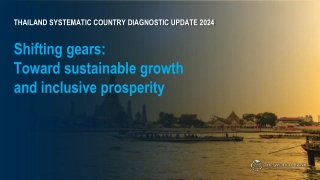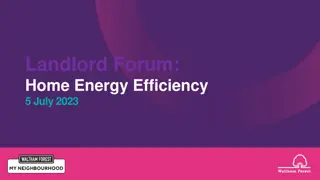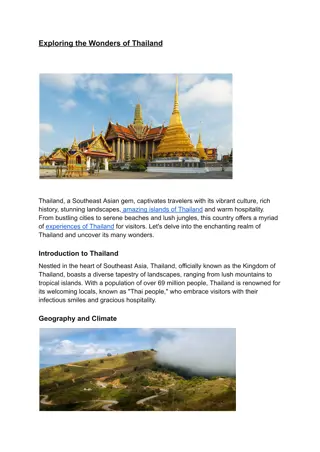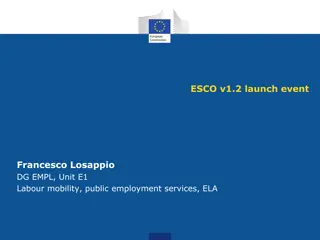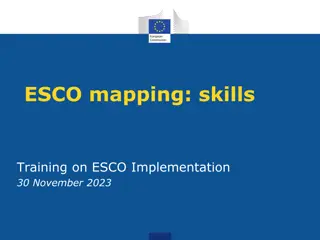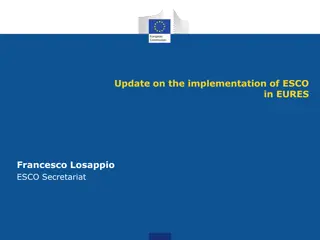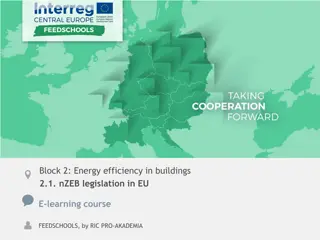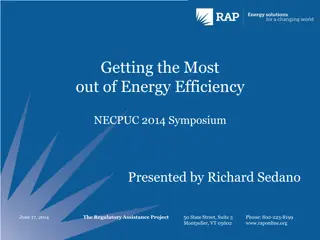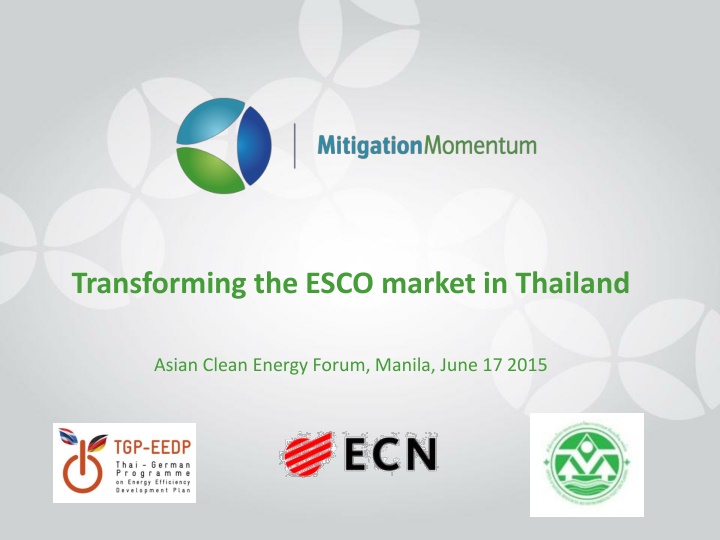
Transforming the ESCO Market in Thailand: Energy Efficiency Initiatives
This content delves into the transformation of the ESCO market in Thailand, highlighting energy efficiency planning, supporting measures, and collaborations to enhance sustainability. It showcases the involvement of key stakeholders, such as the ENCON Fund, GIZ, and various government entities, in promoting energy efficiency and stimulating the ESCO market in Thailand.
Download Presentation

Please find below an Image/Link to download the presentation.
The content on the website is provided AS IS for your information and personal use only. It may not be sold, licensed, or shared on other websites without obtaining consent from the author. If you encounter any issues during the download, it is possible that the publisher has removed the file from their server.
You are allowed to download the files provided on this website for personal or commercial use, subject to the condition that they are used lawfully. All files are the property of their respective owners.
The content on the website is provided AS IS for your information and personal use only. It may not be sold, licensed, or shared on other websites without obtaining consent from the author.
E N D
Presentation Transcript
Transforming the ESCO market in Thailand Asian Clean Energy Forum, Manila, June 17 2015
Introduction ECN Policy Studies Energy research Centre of the Netherlands since 1955 Over 500 staff in seven research areas 60 staff in unit Policy Studies Main think tank for Dutch government on energy and climate. Global Sustainability group Within ECN Policy Studies 15 staff work on issues of global sustainability with a focus on four key themes: Clients include: European Commission, UNFCCC, UNEP, UNDP, CDKN, DFID, GIZ, BMU, WB and the IPCC Experience working in: Indonesia, Kenya, Ghana, South Africa, Argentina, Brazil, Mexico, Kuwait, etc.
Introduction MitigationMomentum Encourage learning on Nationally Approproate Mitigation Action (NAMA) development, and assist selected countries with developing a NAMA proposal ready for finance Project output and collaboration Four NAMA Status Reports Discussion papers on finance, MRV, and ODA Assistance on NAMA development Five country NAMA proposals We are proud to have Thailand participate in the second phase of the MitigationMomentum project Various case specific policy briefs Member ENC think tank; participation international dialogues and workshops
Introduction ECN work together with the GIZ TGP-EEDP program (2012-2015) to develop a NAMA proposal: Improving Energy Efficiency through stimulation of the Thai ESCO market Other partners & stakeholders: Ministry of Natural Resources and Environment (ONEP) Department of Alternative Energy Development & Eff. (DEDE) Thai Credit Guarantee Corporation (TCG) 95% owned by Ministry of Finance Thai ESCO Association (mainly represents smaller ESCOs) ESCOs, commercial banks, energy end-users
Energy Efficiency planning in Thailand 1992 Energy Conservation Promotion (ENCON) Act (and Program) 2010 Energy Efficiency Development Plan (EEDP): 2030 targets Final energy consumption forecast to grow at approx. 4% per year over next 20 years Energy Efficiency Action Plan (EEAP): extended targets to 2036
Supporting measures ENCON Fund: financial support for ENCON program Collects revenue from tax of THB 0.07 (USD 0.002) per litre on petroleum products. Capital = approx. USD 200m annually. Supported by 3 major financial programs which ENCON fund provides capital to: Energy Efficiency Revolving Fund (EERF) (2003-2011): stimulate EE investment in large-scale energy consuming industrial sectors. > THB 5 billion (USD 150m) over three 3-year terms. 1) Tax incentives (2006-present): for EE and RE projects. 2) Energy Service Companies (ESCO) Fund (2008-present): invests in EE and RE projects. THB 500m (USD 15m) in each phase (now announced phase 4) 3)
EEDP and ESCOs Key strategy to achieve EE ambitions (strategy 5 in the EEDP): The use of professionals and Energy Services Companies (ESCO) as an important tool to provide consultancy and to implement energy conservation measures in which the use of more advanced technology is involved . ESCOs are companies providing energy services to final energy users, including, but not necessarily, the supply and installation of energy efficient equipment, building refurbishment, maintenance and operation, facility management and the supply of energy (including heat), accepting some degree of financial risk in doing so (De Boer, 2012).
ESCOs and Energy Performance Contracts (EPCs) ESCO Guaranteed savings ESCO Shared savings ESCO guarantees certain level of savings End-user finances EE project Currently 98.8% of ESCO volume in Thailand Not feasible for many SME end-users ESCO and end-user share the savings ESCO pays back loan with savings Currently 1.2% of ESCO volume in Thailand Requires financially strong and healthy ESCOs Source: IFC (2011) and GIZ (2013)
NAMA objective Overarching goal to increase private sector investment in energy efficiency in Thailand, to realize its savings potential, and support the government in its commitment to energy efficiency by 2020. Transform the ESCO market from a service based business model to EPCs in particular Shared Savings i.e. towards a market where EPCs are commonplace and the ESCO is able to assume business and/or financial risk
Background analysis Identify barriers: Wuppertal Institute study and stakeholder consultations Identify measures to overcome specific barriers Analyse potential impact of these measures ESCO market experts have been hired to provide input on: Thai ESCO market potential and potential impact of the NAMA (energy savings, mitigation potential) Lessons learned from international ESCO markets that could be applied to the Thai context
Barriers to ESCO market growth in Thailand Type of barrier Barrier Financial High up-front capital requirements for energy efficiency technologies Lack of access to capital: banks are cautious to lend to energy efficiency projects therefore have high collateral requirements and charge high interest rates for loans High transaction costs: proportionally when implementing smaller energy efficiency projects Competition for limited finance: finances are reserved for other core business activities Technical Lack of technical knowledge of energy efficiency projects at the bank Lack of technical competency at the ESCO Lack of knowledge/expertise in energy efficiency measures at the end-user Market Lack of trust between the customer and the ESCOs: in the ESCO to be able to deliver the savings they guarantee; in the customer that they will not implement the measures themselves that are put forward by the ESCO Government procurement procedures: not able to use ESCOs Difficult for customers to identify an ESCO (only 14 registered with the ESCO Association) Source: Wuppertal (2014) and stakeholder consultations
NAMA activities and outputs (financial) Loan Guarantee: to overcome barrier of lack of access to capital for EE projects collaboration with Thai Credit Guarantee Corporation (TCG) already offer several guarantee products to SMEs in Thailand Grant scheme: for ESCOs to carry out feasibility studies to create a pipeline of projects (banks need projects to loan to) Pilot projects: at least 2 best practice examples showing the process of application of the guarantee mechanism (to show track record) Training for FIs: improve commercial banks understanding of EE investments and EPC so perceived risk is lower and loans increased
NAMA activities and outputs (technical) Needs assessment and capacity building for government and commercial banks: on EPCs and ESCOs Needs assessment and capacity building for ESCO Association and ESCOs: on Shared Savings business model, standardized EPContracting models and MRV Capacity building and training on the Facilitation Approach: at least 5 pilot projects using EPCs. Train ESCOs on different business models Create transparency in what ESCOs can offer customers Support clients lacking engineering skills, manpower and understanding of risk in identifying and selecting ESCOs Technical assistance facility is established
Potential Impact of the NAMA ESCO market potential: Double turnover of Thai ESCO market from $150 million to $300 million in 2020 Energy savings and mitigation potential (rough, conservative estimates): 2000 - 3000 GWh per year in 2020 1,122,000 Mt CO2e - 1,683,000 Mt CO2e annually in 2020 Co-benefits: Job creation, energy security
Thank you! ! Matthew Halstead halstead@ecn.nl ECN Policy Studies


